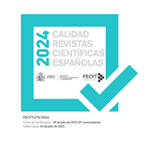Claves del etiquetaje pragmático en el corpus CHILDHUM
Resumen
En el marco de la investigación desarrollada por el grupo GRIALE, una de las líneas más recientes se refiere al análisis del humor verbal infantil. Los diversos proyectos del grupo se han centrado en el estudio del tema en tres franjas etarias –de 8, 10 y 12 años– que abarcan la etapa de educación primaria. La investigación se fundamenta en el análisis de las narraciones humorísticas escritas que conforman el corpus CHILDHUM, actualmente en construcción. El etiquetaje pragmático de las muestras del CHILDHUM –más de 1000 en total para las tres franjas de edad– además de las variables sociolingüísticas habituales (edad, sexo, tipo de centro), incluye la aplicación del sistema de marcas e indicadores de humor (Ruiz Gurillo, 2012; Timofeeva Timofeev y Ruiz Gurillo, 2021) que actúan como soportes lingüísticos en la creación de la comicidad. El análisis de tales marcas e indicadores permite ver la correlación entre su uso y el nivel de maduración metalingüística de nuestros informantes. Asimismo, el etiquetaje pragmático de nuestro corpus ofrece la posibilidad de observar diversos aspectos psicosociales, relativos, por ejemplo, a los estilos de humor (Martin et al., 2003) o la autoestima (Pope et al., 1988; Hosogi et al., 2012), con lo cual podemos proporcionar datos desde la lingüística sobre los procesos madurativos de las diversas competencias humanas imbricadas de alguna manera en el complejo fenómeno del humor verbal.
Descargas
Descarga artículo
Licencia
La revista Círculo de Lingüística Aplicada a la Comunicación, para fomentar el intercambio global del conocimiento, facilita el acceso sin restricciones a sus contenidos desde el momento de su publicación en la presente edición electrónica, y por eso es una revista de acceso abierto. Los originales publicados en esta revista son propiedad de la Universidad Complutense de Madrid y es obligatorio citar su procedencia en cualquier reproducción total o parcial. Todos los contenidos se distribuyen bajo una licencia de uso y distribución Creative Commons Reconocimiento 4.0 (CC BY 4.0). Esta circunstancia ha de hacerse constar expresamente de esta forma cuando sea necesario. Puede consultar la versión informativa y el texto legal de la licencia.











